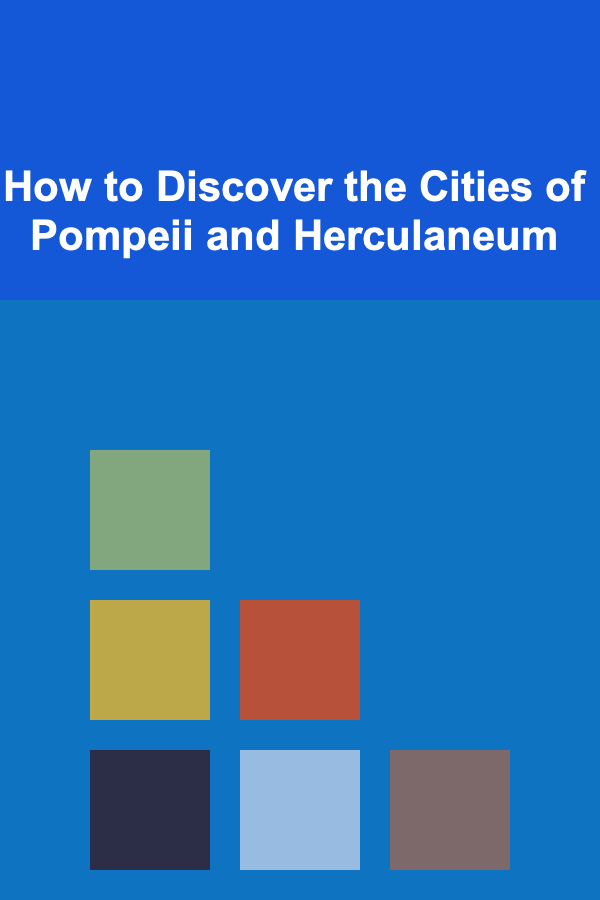
How to Discover the Cities of Pompeii and Herculaneum
ebook include PDF & Audio bundle (Micro Guide)
$12.99$11.99
Limited Time Offer! Order within the next:

Pompeii and Herculaneum, two ancient Roman cities buried by the eruption of Mount Vesuvius in 79 AD, are among the most significant archaeological sites in the world. These cities provide an extraordinary glimpse into the daily life of the ancient Romans, preserved in a moment of time by the volcanic ash that engulfed them. Today, these sites attract millions of visitors, historians, and archaeologists from around the world, seeking to uncover the secrets of these once-thriving cities.
This article explores how you can discover Pompeii and Herculaneum, from their history and excavation to practical tips for visiting, understanding, and experiencing these remarkable sites.
A Brief History of Pompeii and Herculaneum
Pompeii
Pompeii was a prosperous Roman city located near the Bay of Naples in Italy. Founded around the 7th century BC, it flourished as a commercial hub due to its strategic location. The city had a population of around 11,000 to 15,000 people at the time of its destruction. Pompeii's vibrant culture included grand houses, lively marketplaces, bathhouses, theaters, and a variety of temples dedicated to Roman gods.
On August 24, 79 AD, Mount Vesuvius erupted with catastrophic force, spewing ash, pumice, and lava over Pompeii. The city was buried under a thick blanket of volcanic material, preserving it in a state of suspended animation. It remained lost for centuries until its rediscovery in 1748.
Herculaneum
Herculaneum, a smaller but equally important Roman town, was located just a few miles west of Pompeii. The eruption of Vesuvius affected Herculaneum in a slightly different way. While Pompeii was covered with ash and pumice, Herculaneum was submerged by a pyroclastic surge --- a fast-moving cloud of hot gas and ash. This rapid burial preserved Herculaneum's structures even better than Pompeii, including wooden beams, frescoes, and everyday objects, some of which were carbonized but still identifiable.
Herculaneum was rediscovered in 1709, although extensive excavation only began later in the 19th century.
How to Visit Pompeii and Herculaneum
Getting There
Both Pompeii and Herculaneum are easily accessible from Naples, a bustling city that serves as the gateway to the ruins. Whether you arrive by train, car, or guided tour, these cities are only a short distance from the major transportation hubs.
Pompeii
- Train: The Circumvesuviana train line connects Naples to Pompeii, with direct routes running every 30 minutes or so. The journey takes about 30 minutes.
- Car: Pompeii is easily reachable by car, with ample parking available near the entrance.
- Guided Tours: Numerous guided tours depart from Naples, providing in-depth knowledge of Pompeii's history and excavation.
Herculaneum
- Train: The Circumvesuviana line also runs from Naples to Herculaneum. The journey takes around 25 minutes.
- Car: Like Pompeii, Herculaneum is accessible by car, with nearby parking options.
- Guided Tours: Many tours combine both Pompeii and Herculaneum into a single trip, allowing visitors to experience both sites in one day.
When to Visit
The best time to visit Pompeii and Herculaneum is during the spring and fall months, when the weather is mild and the crowds are smaller. Summer can be very hot, especially in the open ruins, and winter months might bring rain.
- Peak Season: June to September
- Off-Peak Season: November to March
- Shoulder Season: April to May, October
Tickets and Entrance Fees
- Pompeii: Tickets to Pompeii cost around €15 for a standard adult ticket. You can also purchase guided tours, which typically cost more.
- Herculaneum: Admission to Herculaneum is typically priced around €13, with discounts available for students and senior citizens.
Key Sites and Features to Explore
Exploring Pompeii
Pompeii is vast, with many different areas to explore. A visit to the site can take anywhere from 3 to 6 hours, depending on how in-depth you wish to go.
-
The Forum The heart of Pompeii's public life, the Forum is a large open square surrounded by temples, government buildings, and markets. Visitors can walk in the footsteps of ancient Romans as they explore the remains of the Temple of Jupiter, the Basilica, and the Market.
-
The House of the Faun This grand residence, one of the largest in Pompeii, is known for its intricate mosaics and lavish architecture. The most famous mosaic in the house is the "Alexander Mosaic," depicting the battle of Issus between Alexander the Great and Darius III of Persia.
-
The Amphitheater The Pompeii Amphitheater is one of the oldest surviving examples of Roman amphitheaters. It could hold around 20,000 spectators, hosting gladiatorial combat and other public spectacles.
-
The Villa of the Mysteries A famous villa on the outskirts of Pompeii, the Villa of the Mysteries contains a remarkable series of frescoes that depict initiation rites associated with the Dionysian cult.
-
The Thermal Baths Pompeii had a number of bathhouses, and the Stabian Baths are among the best-preserved. The complex features rooms for hot, warm, and cold baths, as well as elaborate mosaics and frescoes.
Discovering Herculaneum
While smaller than Pompeii, Herculaneum is often better preserved due to the nature of the eruption that buried it. Many buildings here still contain original wooden structures and organic materials, offering a more intimate experience of ancient Roman life.
-
The House of the Deer One of the most beautiful homes in Herculaneum, the House of the Deer is known for its stunning frescoes and mosaics depicting deer hunting scenes.
-
The Villa of the Papyri The Villa of the Papyri is one of the most extraordinary finds at Herculaneum. This grand villa contained a library of scrolls that were carbonized by the eruption. These scrolls have since been painstakingly examined, providing valuable insight into ancient Roman intellectual life.
-
The Baths of Herculaneum The Herculaneum Baths are smaller but highly detailed compared to those at Pompeii. They feature exquisite mosaics, marble, and frescoes, showing the wealth of the town's inhabitants.
-
The Ancient Beachfront Unlike Pompeii, Herculaneum was preserved by a volcanic surge, which resulted in the preservation of buildings right down to the ground level. You can explore the ancient shoreline, with preserved boathouses and even ancient wooden beams that survived the volcanic destruction.
-
The House of the Mosaic Atrium This house is known for its well-preserved atrium and beautiful mosaics. The artwork showcases scenes of daily Roman life, giving a snapshot of what life was like for the wealthy elite.
Understanding the Archaeology of Pompeii and Herculaneum
The Excavation Process
The excavation of both Pompeii and Herculaneum has been a long and ongoing process. The first attempts to excavate Pompeii began in the 18th century, with the site officially being designated as an archaeological park in the 20th century. Herculaneum's excavation began somewhat later, in the early 19th century.
Archaeologists have used a variety of techniques to uncover these cities, from traditional digging to more advanced methods such as ground-penetrating radar and 3D mapping. In recent years, technologies like drones and robotic exploration have allowed for even more detailed exploration without causing damage to the ruins.
Preserving the Sites
Both Pompeii and Herculaneum face significant threats from environmental factors such as weathering, earthquakes, and tourism. Ongoing conservation efforts are crucial to preserving these ancient sites. In addition to stabilization and restoration work, modern efforts include improving visitor infrastructure and limiting the impact of foot traffic on fragile areas.
The Legacy of Pompeii and Herculaneum
Pompeii and Herculaneum offer a rare window into the ancient Roman world. The cities were frozen in time by the eruption of Mount Vesuvius, allowing modern archaeologists to study Roman society, architecture, art, and daily life in an unprecedented way.
Visiting these cities is not just about seeing ancient ruins, but about connecting with the people who lived there. From their grand homes to their humble shops, the remnants of Pompeii and Herculaneum reveal the richness of life in the Roman Empire. Their preservation is a testament to the resilience of the human spirit and a reminder of the power of nature.
Final Thoughts
To discover Pompeii and Herculaneum is to uncover the heartbeat of ancient Roman civilization. Whether you are a history enthusiast, a student of archaeology, or simply someone looking to explore the wonders of the past, these sites offer a profound and immersive experience.
With careful planning, respect for the site, and a sense of wonder, visitors can step back in time and walk among the ruins of two of the most remarkable cities ever buried by nature's fury. The legacy of Pompeii and Herculaneum lives on, inviting us to discover, learn, and preserve their stories for generations to come.

How to Install Smart Locks for Enhanced Home Security
Read More
How to Use Soundproofing Foam for Maximum Effectiveness
Read More
Public Relations Manager's Handbook: Strategies for Crisis Management and Media Outreach
Read More
The Pros and Cons of Renting Instead of Buying: What You Need to Know
Read More
How To Use Social Media for Direct Response Marketing
Read More
10 Tips for Maintaining Spinal Health at Home
Read MoreOther Products

How to Install Smart Locks for Enhanced Home Security
Read More
How to Use Soundproofing Foam for Maximum Effectiveness
Read More
Public Relations Manager's Handbook: Strategies for Crisis Management and Media Outreach
Read More
The Pros and Cons of Renting Instead of Buying: What You Need to Know
Read More
How To Use Social Media for Direct Response Marketing
Read More